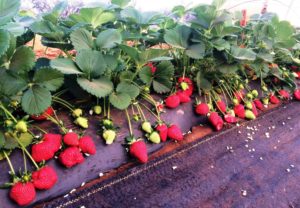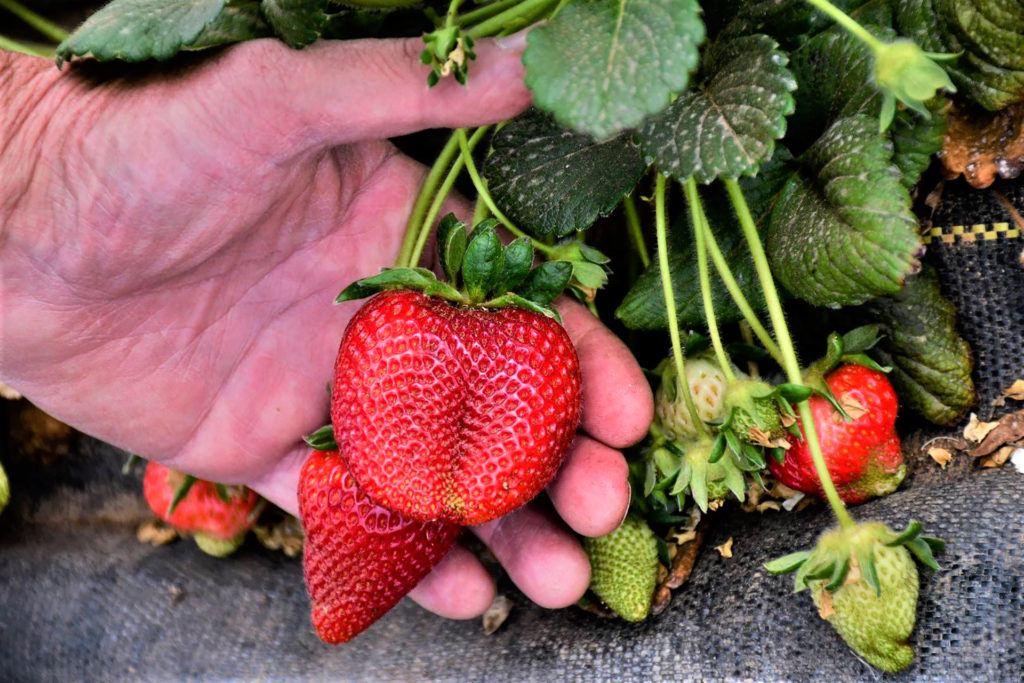- La Feria Community Holds Succesful Business Mixer Event
- Little Nashville to Take Place in Downtown Mercedes
- Lions Basketball Captures District Gold
- La Feria ISD Students Compete in Regional Chess Tournament
- Lions End First Half of 32-4A on a High Note
- La Feria ISD Held Another Successful Parent Conference
- Strong Appearance for Lions at Hidalgo Power Meet
- LFECHS Students Get to Meet Local Actress
- Students Participate in Marine Biology Camp
- Two LFECHS Students Qualify for All-State Band
Texas Strawberry Season Average Amid Up and Down Weather
- Updated: May 21, 2022

Written by Adam Russell
Texas strawberry producers have experienced an average season so far despite freezes, drought and temperature variability impacting yields, according to a Texas A&M AgriLife Extension Service expert.
The growing season started in October with planting, said Russ Wallace, Ph.D., AgriLife Extension horticulturist in Lubbock and professor in Texas A&M’s Department of Horticultural Sciences. Strawberry crowns and root systems develop over winter, and cold temperatures help the plant prepare for fruit production in the spring.
Growth is good around much of the state, but up and down temperatures impacted early season production opportunities, he said. Above-average winter temperatures pushed strawberry plants in East, North and Central Texas to flower early, but a cold front with freezing temperatures knocked off blooms and set plants back.
Last year, Winter Storm Uri also “dinged” strawberry plants, but they recovered and performed well overall, Wallace said.
Fluctuating temperatures somewhat confused the plants this season, he said. Strawberries are a cool-season crop, and while freezing temperatures can hurt blooms and fruit sets, summer-type temperatures can signal the plant to shut down.
Plants typically do well with day temperatures into the low 80 degrees and cooler nights, Wallace said.
Poteet, which is known for its strawberry production, experienced multiple freezes that hurt production, but the area also experienced 100-degree daytime temperatures a few weeks ago, Wallace said.
“Strawberries are very tolerant of cold temperatures, though freezes hurt fruit sets,” he said. “Warmer temperatures signal the plants the end is near. So, if you lose a fruit set or two early to freeze and the plants shut down sooner than they should, it can reduce your production window by several weeks.”
Roller-coaster growing conditions for Texas strawberries
Drought was another factor for strawberry production, Wallace said. Most commercial production acres are irrigated, but meeting plant and fruit daily water-demands at critical stages can influence fruit quality.
“I saw photos of plants around the state earlier this year, and they looked really good,” he said. “After the freeze they reset flowers and were loaded. At that point, if you don’t keep up with the irrigation demand, the strawberries will not fill out properly.”
But too much water can also hurt fruit, Wallace said. Too much water can dilute the brix counts, which is the sugar content measurement in fruits like strawberries and watermelons. Typically, a 9-10 brix count are good for strawberries.
Severe drought can negatively impact strawberries, but drier weather can also help producers by reducing pest and disease pressure, Wallace said. Rainfall and humidity can fuel fungus and mold outbreaks in strawberries, which can be devastating for the crop.
Some strawberry varieties have performed below average this year, Wallace said.
The variety Albion has not performed very well at the Texas A&M AgriLife Research trial plots in Lubbock, Wallace said. He also heard several producers comment about the lack of production by that variety.
Wallace questioned if it could be the fluctuating temperatures, drought or a combination of conditions that led to the subpar performance.
“We don’t really know what happened with that variety this year,” he said. “They’re a day-neutral variety, and so they flower more slowly, and in our area, it can get too hot for them compared to the June-bearing varieties.”
Consumers want local strawberries
Texas strawberry production makes up a small percentage of the nation’s yield. Texas has around 400 acres compared to top-ranked California’s 38,000 acres, Wallace said. Most commercial producers grow anywhere from 1-12 acres and the largest strawberry operation is around 20 acres.
Producers usually grow about 14,000 plants per acre and yields of 1.25 pounds per plant, or 17,500 pounds, are good for growers, he said. Despite the small acreage, the crop has become a lucrative direct-to-consumer product.
Wallace said locally grown strawberries sold at farmers markets or at pick-your-own farms are in high demand throughout the season. They are typically much preferred over strawberries from other states because shipped strawberries are harvested somewhat early to reach grocers in marketable condition.
This season, Wallace has seen prices ranging from $32 for 12 pints, or a flat of strawberries, which is around 8-10 pounds, to $7 per pint at farmers markets, or around three-fourths of a pound of the fruit.
“Consumers are starting to see the difference in locally grown produce, and strawberries are one of those that consumers really want because the taste is so much better,” he said. “There’s just really no comparison.”

AgriLife Extension district reporters compiled the following summaries:
CENTRAL
An area-wide, soaking rain was received, but soil moisture levels remained mostly short. Rains should help wheat finish and keep corn, sorghum and cotton going. Wheat looked good relative to growing conditions, but winter freeze, drought and Hessian flies were likely to impact yields. Leaf rust was becoming an issue. Corn was off to a decent start. Cotton planting wrapped up, and fields were beginning to emerge. Several instances of poor emergence were noted. Pastures were improving with moisture and warmer overnight temperatures. Cattle remained in good body condition with some producers continuing to feed hay on a limited basis. Stock tank levels were unchanged, and runoff rainfall was needed to get them back to comfortable levels.
ROLLING PLAINS
Several counties reported rainfall with totals ranging from 0.5-6 inches. Some areas received light showers and remained relatively dry. Wheat conditions improved after the rains, and irrigated wheat looked good. Some wheat was being grazed, and some fields were cut for hay with up to 1 bale per acre yields reported. Some wheat was being plowed under, but fieldwork was halted by wet conditions. Summer grasses were growing. Ranches were culling herds deeper. Some cotton farmers were still concerned about moisture, and many acres were yet to be planted. Most sorghum was planted, and some emerged in areas with moisture. Some producers planted Sudan grass, and others were waiting for moisture to plant.
COASTAL BEND
Some scattered showers occurred, but only isolated areas received significant rainfall. Emerged crops were holding on. Cotton was mostly planted, and some had emerged, but it appeared some acres failed due to lack of emergence. Crops still needed a soaking rain. All rice acres were planted. Pastures and hay also needed moisture. Livestock were in fair to good condition, and some cattle were being weaned or sold early to help relieve some supplemental feed costs. Most producers were supplementing with hay and protein, but hay supplies were getting short in some areas.
EAST
Rain fell over most of the district with 2-4 inches reported in some areas. Many counties remained behind on rainfall totals for the year. Pasture and rangeland conditions were fair to good. Subsoil and topsoil conditions were short to adequate. Cherokee County reported producers were beginning to cut and bale ryegrass and clover stands. Other counties reported very little ryegrass growth recently. Cattle market prices were good. Livestock were in fair to good condition. Wild pig control remained a problem.
SOUTH PLAINS
Portions of the district received up to 3 inches of rainfall, but some areas remained dry. Fire danger was high with high temperatures and strong winds. Cattle were being provided supplemental feed.
PANHANDLE
Soil moisture levels were very short to short. Light rain arrived midweek, but much more was needed to change extreme dry conditions. Conditions continued to decline with high winds and above normal temperatures. Irrigated wheat stages ranged from flagging to pre-boot, depending on how much water was applied to the field. Crop, rangeland and pasture conditions were very poor to poor.
NORTH
Soil moisture was adequate across the district. Temperatures for the week were around 70 degrees. Winds were constant. There was 1-2 inches of rainfall, which helped grass growth. Winter pasture grazing continued. Most row crops were planted and looked good. Winter wheat looked good. Corn emerged and looked good. Fruit trees also looked good. Livestock were in good condition, and spring-born calves were faring well.
FAR WEST
Average high temperatures were 91 degrees with average low temperatures of 48 degrees. Overall, conditions remained extremely dry, and fire danger continued to be a concern, with 20-30 mph sustained wind most days. Precipitation ranged from trace amounts up to half an inch and some damaging hail. A tornado touched down in Pecos County and tore up fences and barns. Fieldwork was on hold until rains improve moisture conditions. Watermelons were planted and being irrigated. Corn was struggling due to short moisture. Cotton planting should begin soon. Pastures were bare, and there were reports of trees dying. Mesquite trees were still struggling to bud out. Livestock producers were supplementing cattle diets with hay and protein because pastures were in poor condition. Cattle were in fair shape considering the conditions, but some ranchers were expected to wean and ship early if poor conditions continued. Wheat fields were being used to make hay rather than take the crop to grain production. Working of lambs and kid goats was in full swing. Irrigation in pecans and alfalfa continued. No pests were reported in pecan orchards, but producers were spraying. Most Pima cotton was planted, and planted cotton had emerged.
WEST CENTRAL
Some parts of the district received some much-needed rain, while the majority stayed dry. Most areas were in desperate need of rain to improve rangeland and soil moisture conditions. Pastures were struggling to green up, and mesquite trees were flowering. Irrigated wheat was maturing. The number of cows at the sale barns increased. Short availability of grazing meant cattle had to be supplemented with high-priced feed.
SOUTHEAST
Parts of the district reported rainfall, but some areas had already dried. Soil moisture levels were short to adequate. Rainfall should help pastures. Producers reported favorable growing conditions. Temperatures were warmer. Ryegrass continued to decline, and warm season grasses were emerging. Some rice was planted, but other rice plantings were delayed by rainfall. Rangeland and pasture conditions were very poor to excellent with mostly fair ratings.
SOUTHWEST
Rainfall amounts ranged from 0.75 of an inch to 3 inches. Increased moisture helped corn, sorghum, cotton and wheat. Pasture and rangeland conditions improved slightly from the rain. Windy conditions continued across most of the area. Weather conditions continued to be hot and dry. More rainfall was needed as summer approaches. Supplemental feeding of livestock and wildlife continued.
SOUTH
Northern and western parts of the district were very short on moisture. Eastern areas reported short moisture levels, and southern areas were short to adequate. Some areas received rainfall with totals ranging from trace amounts up to 6 inches. Some croplands had standing water in low spots. Row crop farmers were monitoring fields for emergence, but most grain and cotton had not emerged yet. Corn producers reported earworms in non-Bt varieties. Corn and sorghum fields were under irrigation. Onion harvest was wrapping up. Sugarcane aphids were reported in some sorghum fields. Some cotton aphid pressure was reported as well. Irrigation slowed in areas that received rainfall. Strawberries were still coming off, and vegetable crops were being harvested or planted. Citrus producers continued to manage trees and were hoping for better production this season. Irrigated Coastal Bermuda grass fields were producing bales. Pastures and croplands were in very poor condition in many areas, and most crops were expected to be insured out due to continued drought conditions. Wildlife and livestock were still suffering from lack of forage. Cattle producers were relying on supplemental feed, but rainfall was expected to help pastures and rangelands. Feed prices continued to rise. Some pastures and rangelands responded to the rainfall but will need time to grow for grazing. Southern areas reported hay pastures were in good condition. Stock tanks were replenished depending on rainfall-runoff, but some water levels continued to decline. Cattle prices were consistent at local markets.





